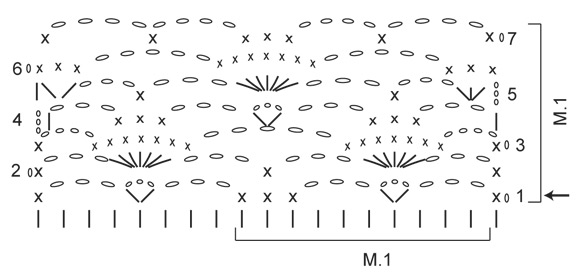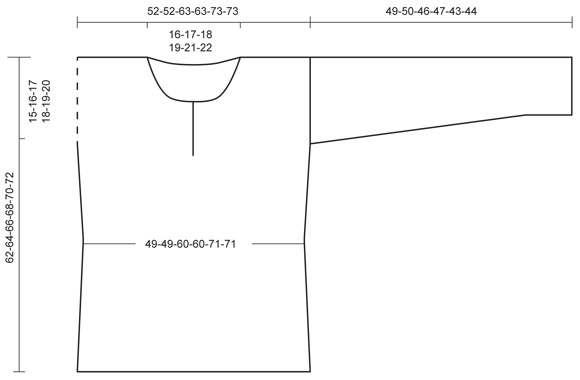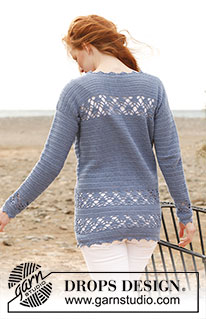Country Dream |
|||||||||||||
 |
 |
||||||||||||
Crochet DROPS tunic in ”Safran”. Size: S - XXXL.
DROPS 136-25 |
|||||||||||||
|
DC ROWS: Beg every dc row with ch 3 (not counted as 1st dc), work 1 dc in 1st st, then 1 dc in every st, turn. PATTERN: See diagram M.1. 1 repetition of diagram M.1 = 10 dc in width and 7 rows vertically. DECREASE TIP: Work 1 dc but wait with last pull through (= 2 sts on hook), then work next dc but on last pull through, pull thread through all sts on hook = 1 st dec. INCREASE TIP: Inc 1 st in each side of piece by working 2 dc in 1st and last st on row. --------------------------------------------------------- BACK PIECE: Read US/UK above! Worked back and forth. Loosely work 102-102-122-122-142-142 ch on hook size 3.5 mm/E/4 with Safran. Work 1st row (= RS) as follows: Work 1 dc in 4th ch from hook, then 1 dc in every ch, turn = 99-99-119-119-139-139 dc (= 9-9-11-11-13-13 repetitions of diagram M.1 + 9 sts). REMEMBER THE CROCHET GAUGE! Then work 3-3-4-4-5-5 dc ROWS - Read explanation above = 4-4-5-5-6-6 dc rows vertically. Continue to work diagram M.1 as follows: ROW 1: ch 1, 1 sc in 1st dc, * ch 3, skip the next 3 dc, in next dc work as follows: 1 dc, ch 3, 1 dc, then ch 3, skip the next 3 dc, 1 sc in each of the next 3 dc (= 3 sc) *, repeat from *-* the rest of row. When repeating from *-* the last time work ch 3, skip the next 3 dc and work 1 sc in last dc, turn. ROW 2: ch 1, 1 sc in 1st sc, * ch 3, skip next ch-space, 7 dc in next ch-space (between 2 dc), ch 3, 1 sc in the middle sc from 1ST ROW *, repeat from *-* the rest of row. When repeating from *-* the last time work 3 ch and 1 sc in last sc, turn. ROW 3: ch 1, 1 sc in 1st sc, ch 4, * 1 sc in each of the next 7 dc (= 7 sc), ch 5 *, repeat from *-* the rest of row, finish with ch 4 and 1 sc in last sc, turn. ROW 4: ch 3, 1 dc in 1st ch-space, * ch 3, 1 sc in the middle of the 3 sc from 3RD ROW (= 3 sc), ch 3, [1 dc, ch 3, 1 dc] in next ch-space *, repeat from *-* the rest of row. When repeating from *-* the last time work ch 3 and 1 dc in last ch-space, turn. ROW 5: ch 3, 3 dc in 1st ch-space, * ch 3, 1 sc in the middle sc from 4TH ROW, ch 3, skip next ch-space, 7 dc in next ch-space (between 2 dc) *, repeat from *-* the rest of row. When repeating from *-* the last time work ch 3, 2 dc in last ch-space and 1 dc in 3rd ch from 4TH ROW, turn. ROW 6: ch 1, 1 sc in each of the next 3 dc (= 3 sc), * ch 5, 1 sc in each of the next 7 dc (= 7 sc) *, repeat from *-* the rest of row. When repeating from *-* the last time work 1 sc in each of the last 3 dc (= 3 sc), turn. ROW 7: ch 1, 1 sc in 1st sc, * ch 4, 1 sc in next ch-space, ch 4, 1 sc in each of the middle 3 sc from 6TH ROW (= 3 sc) *, repeat from *-* the rest of row. When repeating from *-* the last time work ch 4 and 1 sc in last sc, turn. Then work 1 sc row as follows: ch 1, 1 sc in 1st sc, * 4 sc in next ch-space, 3 sc in next ch-space, 1 sc in each of the next 3 sc *, repeat from *-* the rest of row. When repeating from *-* the last time, work 1 sc in last sc = 99-99-119-119-139-139 sc. Work another 4-4-5-5-6-6 dc rows, then diagram M.1 1 time vertically, and then 1 sc row the same way - while AT THE SAME TIME dec 1 st at the end of row - Read DECREASE TIP above = 98-98-118-118-138-138 sts. Piece now measures approx. 20-20-22-22-24-24 cm / 8"-8"-8¾"-8¾"-9½"-9½". Then work 2-3-2-3-2-3 dc rows (piece measures approx. 22-23-24-25-26-27 cm / 8¾"-9"-9½"-9¾"-10¼"-10⅝"). On next row dec 4 sts evenly on row = 94-94-114-114-134-134 dc. Continue with dc rows until piece measures 27-28-29-31-32-33 cm / 10⅝"-11"-11⅜"-12¼"-12½"-13". On next row, inc 1 st in each side of piece - Read INCREASE TIP above. Repeat inc one more time when piece measures 34-35-36-37-38-39 cm / 13⅜"-13¾"-14¼"-14½"-15"-15¼". When piece measures 40-41-42-44-45-46 cm / 15¾"-16⅛"-16½"-17¼"-17¾"-18", inc 1 st at end of row = 99-99-119-119-139-139 dc. When piece measures 47-48-49-50-51-52 cm / 18½"-19"-19¼"-19¾"-20"-20½", work from RS as follows: Diagram M.1 1 time and 1 sc row as before. NOTE: Insert a marker in each side of piece on 1st row in diagram M.1 (armhole beg here). Continue with dc rows until piece measures 60-62-64-66-68-70 cm / 23⅝"-24⅜"-25¼"-26"-26¾"-27½". Then work 1 dc row over the outermost 35-34-43-42-51-50 sts in each side (i.e. do not work over the middle 29-31-33-35-37-39 sts (= neck), then dec 1 st on next row towards the neck = 34-33-42-41-50-49 sts remain on shoulder. Cut and fasten the thread, piece measures approx. 62-64-66-68-70-72 cm / 24⅜"-25¼"-26"-26¾"-27½"-28⅜". FRONT PIECE: Work as back piece until piece measures 42-44-45-47-48-50 cm / 16½"-17¼"-17¾"-18½"-19"-19¾". LEFT FRONT PIECE: On next row from RS work vent as follows: Work 49-49-59-59-69-69 dc (= 4-4-5-5-6-6 repetitions of diagram + 9 sts), turn. Continue with dc rows. When piece measures 47-48-49-50-51-52 cm / 18½"-19"-19¼"-19¾"-20"-20½", work diagram M.1 (beg from RS) 1 time vertically. NOTE: Insert a marker in the left side of piece (seen from RS) on 1st row in diagram M.1 (armhole beg here). Then work 1 sc row as before = 49-49-59-59-69-69 sc. On next row from RS work neck as follows: Work until 8-8-9-9-10-10 sts remain on row, turn. Then dec on every row towards the neck as follows: Dec 2 sts 2 times - Read DECREASE TIP above, 1 st 3-4-4-5-5-6 times = 34-33-42-41-50-49 sts remain on shoulder. Continue until piece measures 62-64-66-68-70-72 cm / 24⅜"-25¼"-26"-26¾"-27½"-28⅜", fasten off. RIGHT FRONT PIECE: = 50-50-60-60-70-70 dc. On next row dec 1 st at beg of row = 49-49-59-59-69-69 dc. Work as left front piece but reversed. SLEEVE: Worked back and forth. Ch 42-42-42-52-52-52 on hook size 3.5 mm/E/4 . Work 1st row (= RS) as follows: Work 1 dc in 4th ch from hook, then 1 dc in every ch, turn = 39-39-39-49-49-49 dc (= 3-3-3-4-4-4 repetitions of diagram M.1 + 9 sts), turn. Then work 2 dc rows = 3 dc rows vertically. Then work diagram M.1 1 time and 1 sc row = 39-39-39-49-49-49 sc. On next row work dc - while AT THE SAME TIME inc 1 st in each side of piece. Continue with dc rows and repeat inc every 4½-3½-2½-3½-2½-2½ cm / 1¾"-1¼"-⅞"-1¼"-⅞"-⅞" a total of 9-11-13-10-12-13 times = 57-61-65-69-73-75 sts. Continue until piece measures 49-50-46-47-43-44 cm / 19¼"-19¾"-18"-18½"-17"-17¼" (shorter measurements in the larger sizes because of wider shoulders), fasten off. ASSEMBLY: Sew the shoulder seams. Sew in sleeves between markers in each side. Sew sleeve and side seams in one. CROCHET EDGE - BODY: Work along the bottom edge of tunic as follows: ROUND 1: Beg in left side seam, work ch 1, 1 sc in every dc - AT THE SAME TIME inc 2 sc evenly on round = 200-200-240-240-280-280 sc (no of sts divisible by 8), finish with 1 sl st in 1st sc. ROUND 2: ch 1, 1 sc in 1st sc, * ch 3, skip 3 sc, 1 sc in next sc *, repeat from *-* the entire round, finish with ch 3, skip the last 3 sc and work 1 sl st in 1st sc. ROUND 3: ch 1, in 1st ch-space work as follows: 1 sc, ch 3, 1 sc, * in next ch-space work as follows: 3 dc, ch 3, 1 sl st in 1st ch, 3 dc, in next ch-space work as follows: 1 sc, ch 3, 1 sc *, repeat from *-* the entire round, finish with 1 sl st in 1st sc, cut and fasten the thread. CROCHET EDGE - SLEEVE: Work an edge around bottom edge of sleeve as follows: Size S - L ROUND 1: Beg in sleeve seam, work ch 1, 1 sc in every dc - AT THE SAME TIME inc 1 st at end of round = 40-40-40 sc (no of sts divisible by 8), finish with 1 sl st in 1st sc. ROUND 2: ch 1, 1 sc in 1st sc, * ch 3, skip 3 sc, 1 sc in next sc *, repeat from *-* the entire round, finish with ch 3, skip the last 3 sc and work 1 sl st in 1st sc. ROUND 3: ch 1, in 1st ch-space work as follows: 1 sc, ch 3, 1 sc, * in next ch-space work as follows: 3 dc, ch 3, 1 sl st in 1st ch, 3 dc, in next ch-space work as follows: 1 sc, ch 3, 1 sc *, repeat from *-* the entire round, finish with 1 sl st in 1st sc, fasten off. Size XL - XXXL: ROUND 1: Beg in sleeve seam, ch 1, 1 sc in every dc - AT THE SAME TIME dec 1 st at end of round = 48-48-48 sc (no of sts divisible by 8), finish with 1 sl st in 1st sc. Work 2ND and 3RD round as size S - L. Repeat on the edge of the other sleeve. CROCHET EDGE - NECK: Work an edge back and forth along the vent and neck edge as follows: ROW 1: Beg at the bottom of vent mid front, ch 1, 21-21-21-17-17-17 sc along vent on right front piece (no of sts divisible by 4 + 1), then 83-83-91-91-99-99 sc along neck edge, finish with 21-21-21-17-17-17 sc along vent on left front piece = 125-125-133-125-133-133 sc in total, turn. ROW 2: ch 1, 1 sc in 1st sc, * ch 3, skip 3 sc, 1 sc in next sc *, repeat from *-* the rest of row, turn. ROW 3: ch 1, in 1st ch-space work as follows: 1 sc, ch 3, 1 sc, * in next ch-space work as follows: 3 dc, ch 3, 1 sl st in 1st ch, 3 dc, in next ch-space work as follows: 1 sc, ch 3, 1 sc *, repeat from *-* the rest of row, fasten off. |
|||||||||||||
Diagram explanations |
|||||||||||||
|
|||||||||||||

|
|||||||||||||

|
|||||||||||||
|
Have you made this or any other of our designs? Tag your pictures in social media with #dropsdesign so we can see them! Do you need help with this pattern?You'll find tutorial videos, a Comments/Questions area and more by visiting the pattern on garnstudio.com. © 1982-2024 DROPS Design A/S. We reserve all rights. This document, including all its sub-sections, has copyrights. Read more about what you can do with our patterns at the bottom of each pattern on our site. |
|||||||||||||





































Comments / Questions (35)
Is there a size chart available to show what sizes S,M,L,XL,XXL,XXL refer to please?
21.12.2013 - 18:36DROPS Design answered:
Dear Mrs Chimley, you will find at the bottom of the page (end of written pattern) a measurement chart with all measurements in cm. Happy crocheting!
27.12.2013 - 13:08Ich komme jetzt an der Stelle nicht weiter, in der es am Halsauschnitt wie folgt gehen soll: 2 mal 2M., 3 mal 1 M. Soll ich da 4 Maschen zusammenfassen oder übrig lassen und wie ist die Verteilung auf die Reihen? Das verstehe ich nicht ganz. Liebe Dank für die Rückmeldung!
01.10.2013 - 18:38DROPS Design answered:
Liebe Sarah, die Maschen werden durch Zusammenhäkeln abgenommen, damit keine "Treppe" entsteht, also über 4 M je 2 zusammenhäkeln = 2 M abgenommen. Es wird in jeder R abgenommen (siehe Anleitung).
02.10.2013 - 09:54Wat is die uitleg van jullie supergoed, zelfs ik snap het!!! Met vriendelijke groeten
11.09.2013 - 15:17Geachte mevrouw, Is er geen omschrijving voor een V-hals? Zoals duidelijk te zien is op het voorbeeld? Een V-hals bij het M1-patroon is veel mooier dan een split. Kunt u mij hiervoor een instructie leveren? Met vriendelijke groet en dank.
08.04.2013 - 00:14DROPS Design answered:
In het patroon staat hoe u de hals moet haken. Door de beschrijving te volgen vormt u een v-hals. Bij het afwerken haakt u ook een rand om de hals om deze helemaal af te maken.
08.04.2013 - 19:16Kiitos selvennyksestä. Eli kavennukset vaativat 10 kerrosta yhteensä. Ongelmana on myös se, että minulla tuon kuvion ja olkapään väliin jää vain 9 kerrosta, täytynee kaventaa vähän nopeammin.
23.01.2013 - 12:57Mitä tarkoittaa etukappaleen kavennus kaula-aukon kohdalla? 'Kavenna sitten pääntien reunassa joka 2. krs: 2 x 2 s ja 3-4-4-5-5-6 x 1 s' Eli kavennanko yhdellä kerroksella 4 silmukkaa? Seuraavalla 3 silmukkaa? En ymmärrä tuota 2 kertaa 2s?
18.01.2013 - 11:35DROPS Design answered:
Päätät 2 x 2 s joka 2. krs näin: Päätä pääntien reunasta 2 s. Neulo 1 välikerros. Päätä sitten seuraavalla krs:lla uudestaan 2 s. Tee samalla tavalla myös jatkossa, eli päätä 1 s, neulo välikerros jne.
21.01.2013 - 16:40Ska det ses som ökning med 1m per varv de första ST-varven. Eller ska de 3 lm i början inte alls ses som st. Inte heller då man vänt o de är i slutet av varvet?
31.08.2012 - 09:48DROPS Design answered:
ST-VARV: Varje v med st börjar med 3 lm (räknas inte som 1:a st), virka 1 st i 1:a m, sedan 1 st i varje m, vänd.
13.12.2012 - 12:24Sto cercando di capire come si esegue questo lavora ma non sono molto pratica e non riesco a capire alcune istruzioni. Nell'eseguire il DIETRO dopo aver lavorato le 99 m.b. sul decoro M1 e e aver continuato con le 4 ripetizioni di9 m.a. nelle istruzioni è indicato di eseguire il diagramma M1 1 volta in verticale . Cosa intendete ?
12.07.2012 - 21:16DROPS Design answered:
Chiedo scusa per non aver risposto prima. 1 volta in verticale = il diagramma M1 deve essere lavorato 1 volta in altezza, cioè ripeterlo tutte le volta che ci vogliono orizzontalmente, ma solo una volta in altezza. Praticamente si tratta di un bordo.
18.07.2012 - 11:31Sto cercando di capire come si esegue questo lavora ma non sono molto pratica e non riesco a capire alcune istruzioni. Nell'eseguire il DIETRO dopo aver lavorato le 99 m.b. sul decoro M1 e e aver continuato con le 4 ripetizioni di9 m.a. nelle istruzioni è indicato di eseguire il diagramma M1 1 volta in verticale . Cosa intendete ?
12.07.2012 - 15:59Volgens de fot is dit een trui met een V-hals, maar als ik het patroon goed begrijp en de tekening erbij zie dan is het een trui met een split en een ronde hals. Hoe zit dat?
25.04.2012 - 19:55DROPS Design answered:
Het is een split en vervolgens ronde hals. De split is ca 4 cm hoog en vervolgens komen de minderingen voor de hals. Het is niet zo duidelijk te zien door de gehaakt rand - maar hij is er.
25.04.2012 - 20:24